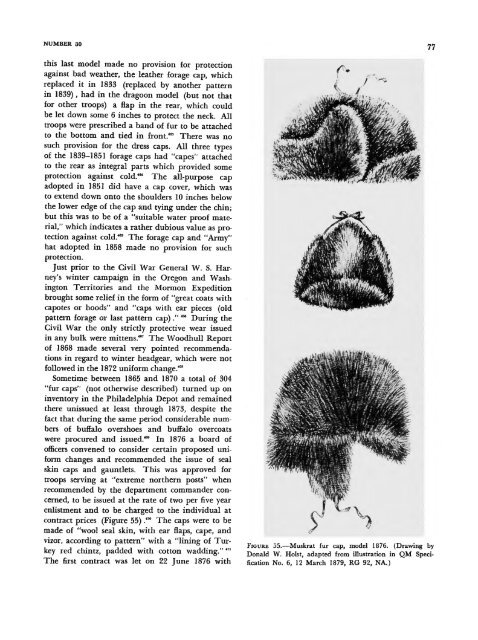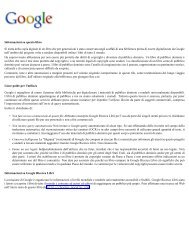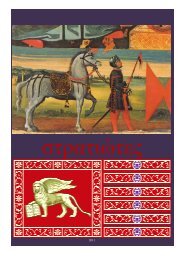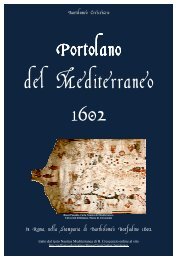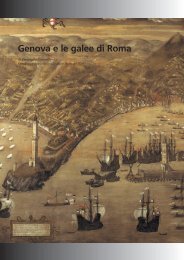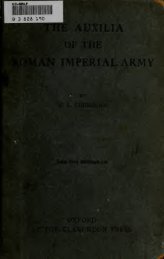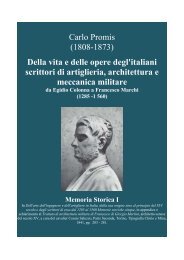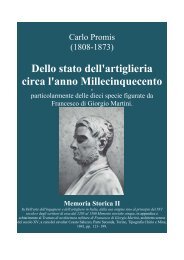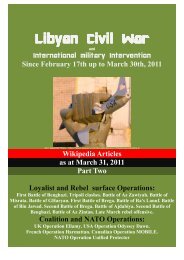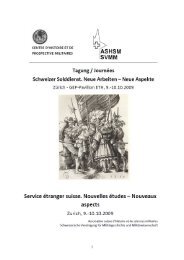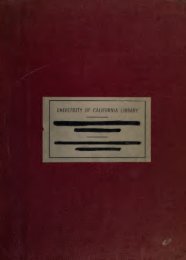76 SMITHSONIAN STUDIES IN HISTORY AND TECHNOLOGY5th instant the Secretary adopted a standard corkhelmet for the Artillery School and I suggest thishelmet be made also the standard for the <strong>Army</strong>."He went on that it was very hot in Texas and thatthe 1st Infantry would need the headgear quickly.He estimated the cost per helmet would be $3.00to $3.50 each.'^' This recommendation regardingthe whole <strong>Army</strong> the Secretary approved, and on thefollowing day Meigs directed the Philadelphia Depotto purchase immediately 500 helmets in anticipationof a requisition from Shafter's unit. Thesewere purchased from Horstmann.'^'Approval of the helmet was formalized in GeneralOrder No. 72, Headquarters of the <strong>Army</strong>, 4November 1880, issue to be made only to troopsin hot climates and then in lieu of campaign hats,the necessity to be certified by the departmentcommander. The rate of issue was to be one eachfor the first and third years of an enlistment. Thefirst contract was let with Apple & Co. of Philadelphia,25 May 1881, for 6000 at $1.69 each, thisprice dropping to $1.43i/4 by 1883.'"There was some minor experimentation with thehelmet in the next few years that should be mentioned.A model made of crushed cork, as opposedto laminated sheet cork, was tried and found to beimpractical. As a result of a number of complaintsthat the white helmet offered too conspicuous atarget, both khaki and "drab" covered helmetswere issued for trial.'"'' These trials were seeminglyinconclusive as there was no general issue of otherthan white helmets until the turn of the century.The original specifications remained in forcefrom 1880 to 1899 with the exception of a veryslight change in weight in 1892.'^' In 1899, however,there was a distinct change in shape, dimensions,and color. All to be covered with "GovernmentStandard Khaki," and the visor width increasedfrom 2 to 21/2 inches in front and from 2i/2to SYs inches in the rear to give greater protectionto the neck."' Then in 1900 came specifications for"Cork Helmets (khaki and white)," essentially thesame model as that of the previous year except thatthe visor was to be lined with green wool instead ofcotton."*" Specimens examined generally conformwith very slight tolerance except that no examplehas been seen with a wool visor lining. These lastspecifications were the basis for all subsequent issuesof the helmet, which generally carried throughthe Philippine Insurrection period. It is interestingto note that the <strong>1902</strong> uniform change called forboth a white and a "service" helmet for all personnel.General Order No. 197, War Department, 31December 1904, gave final clarification of the statusof both white and khaki, directing that they beissued until exhausted and then discontinued.'""One officer's model has been examined, that belongingto Captain Charles Garnett Gordon, 6thCavalry, who served from 1867-1887. This specimen(Figure 54), which should not be confusedwith the officers' summer helmet authorized in thegeneral order prescribing a helmet for the whole<strong>Army</strong>, seems to have done double duty for field orfatigue use in place of the campaign hat, as well asfor a dress helmet, in that it is fitted with chinchain side and rear buttons and shows evidence ofhaving had the oak leaf spike or plume base attached.It resembles more nearly the shape anddimensions of the 1899 model than the 1880, iscovered with a white wool flannel, and carries themaker's label "Henry V. Allien & Co./New York."THE WINTER CAPNo authenticated example of the winter capsissued between 1876-<strong>1902</strong>, either fur or canvas, isin the National Collections or is known to thewriter. Discussion of these is included because ofthe widespread use of the models.Although a headpiece especially designed forwear in cold climate was not authorized until 1876,in addition to field expedients that one can be sureboth officers and enlisted men used in extremes ofweather, there were a few instances where the <strong>Army</strong>did make provision of a sort for the protection ofthe head and ears against cold.The earliest recorded example of an issue wintercap was the gray wool forage cap authorized in1820 and described as designed to "be worn so asto cover the greater part of the face and jaws,which is considered to be important in cold climate.'"Actually in this particular instance protectionwas admittedly secondary to appearance as evidencedin the change to the 1825 pattern."" While
NUMBER 30this last model made no provision for protectionagainst bad weather, the leather forage cap, whichreplaced it in 1833 (replaced by another patternin 1839), had in the dragoon model (but not thatfor other troops) a flap in the rear, which couldbe let down some 6 inches to protect the neck. Alltroops were prescribed a band of fur to be attachedto the bottom and tied in jEront."" There was nosuch provision for the dress caps. All three typesof the 1839-1851 forage caps had "capes" attachedto the rear as integral parts which provided someprotection against cold/" The all-purpose capadopted in 1851 did have a cap cover, which wasto extend down onto the shoulders 10 inches belowthe lower edge of the cap and tying under the chin;but this was to be of a "suitable water proof material,"which indicates a rather dubious value as protectionagainst cold.'** The forage cap and "<strong>Army</strong>"hat adopted in 1858 made no provision for suchprotection.Just prior to the Civil War General W. S. Harney'swinter campaign in the Oregon and WashingtonTerritories and the Mormon Expeditionbrought some relief in the form of "great coats withcapotes or hoods" and "caps with ear pieces (oldpattern forage or last pattern cap)." '" During theCivil War the only strictly protective wear issuedin any bulk were mittens.'" The Woodhull Reportof 1868 made several very pointed recommendationsin regard to winter headgear, which were notfollowed in the 1872 uniform change.'""Sometime between 1865 and 1870 a total of 304"fur caps" (not otherwise described) turned up oninventory in the Philadelphia Depot and remainedthere unissued at least through 1873, despite thefact that during the same period considerable numbersof buffalo overshoes and buffalo overcoatswere procured and issued.*** In 1876 a board ofofficers convened to consider certain proposed uniformchanges and recommended the issue of sealskin caps and gauntlets. This was approved fortroops serving at "extreme northern posts" whenrecommended by the department commander concerned,to be issued at the rate of two per five yearenlistment and to be charged to the individual atcontract prices (Figure 55).' The caps were to bemade of "wool seal skin, with ear flaps, cape, andvizor, according to pattern" with a "lining of Turkeyred chintz, padded with cotton wadding." *"The first contract was let on 22 June 1876 withFIGURE 55.—Muskrat fur cap, model 1876. (Drawing byDonald W. Hoist, adapted from illustration in QM SpecificationNo. 6, 12 March 1879, RG 92, NA.)77
- Page 1:
• ^ - :lP-'L^ry\'^ ^iT
- Page 4 and 5:
ABSTRACTHowell, Edgar M. United Sta
- Page 7 and 8:
ContentsPagePrefaceiiiThe 1855 Cava
- Page 9 and 10:
United States Army Headgear 1855-19
- Page 11 and 12:
NUMBER 30report, stated: "The hat p
- Page 13 and 14:
NUMBER 30acorns %g inches long and
- Page 15 and 16:
NUMBER 30the pattern." The rate of
- Page 17 and 18:
NUMBER 30FIGURE 3.—1858 Army hat.
- Page 19 and 20:
NUMBER 3011model, number 60 in the
- Page 21 and 22:
NUMBER 30 13"the desired modificati
- Page 23 and 24:
NUMBER 30 15the sun in the top. The
- Page 25 and 26:
NUMBER 30 17FIGURE 8.—1858 forage
- Page 27 and 28:
NUMBER 30 19Hardtack and Coffee, ca
- Page 29 and 30:
NUMBER 3021FIGURE 11.—a, Brigadie
- Page 31 and 32:
NUMBER 30 23short "shell" jacket "f
- Page 33 and 34: NUMBER 30 26broad, securely soldere
- Page 35 and 36: NUMBER 30 27worn in the picture wer
- Page 37 and 38: NUMBER 30 29This communication elic
- Page 39 and 40: NUMBER 30 31FIGURE 17.—"The [Scot
- Page 41 and 42: NUMBER 30 33time for issue in the c
- Page 43 and 44: NUMBER 30 35be at too great a dista
- Page 45 and 46: NUMBER 3037half (5/2) part of washb
- Page 47 and 48: NUMBER 30 39trimmings for all enlis
- Page 49 and 50: NUMBER 30 41ing the upper space for
- Page 51 and 52: NUMBER 30rear one to a correspondin
- Page 53 and 54: NUMBER 30 46FIGURE 29.—1872 enlis
- Page 55 and 56: NUMBER 3047FIGURE 32.—^The Bent &
- Page 57 and 58: NUMBER 3049of strong split-leather
- Page 59 and 60: NUMBER 30 51''""MttfenFIGURE 35.—
- Page 61 and 62: NUMBER 30 53(which he thought might
- Page 63 and 64: NUMBER 30 55FIGURE 38.—Captain Be
- Page 65 and 66: NUMBER 30 57campaign hat for the Ar
- Page 67 and 68: NUMBER 30 59salvage something from
- Page 69 and 70: NUMBER 30 61hat. In June 1899 the P
- Page 71 and 72: NUMBER 3063the left side, pass diag
- Page 73 and 74: NUMBER 30 65.LJU^.."*^..FIGURE 44.
- Page 75 and 76: NUMBER 30 67to be sent to Washingto
- Page 77 and 78: NUMBER 30 69with brass sliding-buck
- Page 79 and 80: NUMBER 30 71FIGURE 48.—Officers'
- Page 81 and 82: NUMBER 3073The adoption of the whit
- Page 83: NUMBER 3075i >•^\Wiii I ifiiiniim
- Page 87 and 88: NUMBER 30 79WAR DEPARTMENT,QUARTERM
- Page 89 and 90: NUMBER 3081FIGURE 58.—1864 chapea
- Page 91 and 92: NUMBER 30geon 1880 and Surgeon Gene
- Page 93 and 94: NUMBER 3085FIGURE 63.—1895 forage
- Page 95 and 96: NUMBER 30 87of not less than 9.24 g
- Page 97 and 98: AppendixMAKERS OF HEADGEARThe chron
- Page 99 and 100: List of AbbreviationsAAGAAQMAGAGOAQ
- Page 101 and 102: NUMBER 3093all OQMG, LS, Clothing,
- Page 103 and 104: NUMBER 30 95"Jesup to Thomas, 8 Dec
- Page 105 and 106: NUMBER 3097OQMG, Reg. LR, Clothing,
- Page 107 and 108: NUMBER 30 99October of 1870. See Me
- Page 109 and 110: NUMBER 30 101'"* See above, pp. 35-
- Page 111 and 112: NUMBER 30 103Monroe, Va., in 1878.
- Page 113 and 114: NUMBER 30 105""Endorsement, 24 May
- Page 115 and 116: ReferencesThe bulk of the source ma
- Page 117: M MBIiR 30 10910, No. 355-10, 19 Se


